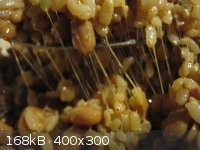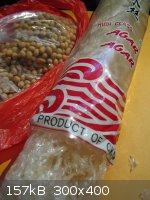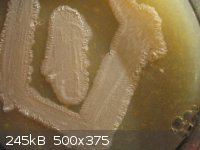food
Hazard to Self
 
Posts: 86
Registered: 4-9-2010
Location: the West
Member Is Offline
Mood: mithering
|
|
bacillus subtilis, transfer and culture
Natto is the Japanese name for a foodstuff prepared by treating cooked soy beans with bacillus subtilis 'natto' resulting in a strong smelling, slimy
conglomeration of colonized beans. Although best known by the Japanese name, this is a traditional preparation that is widespread across Asia as, for
example Kinema in N.E. India, Bekang in Mizoram, Thua Nao in Thailand and no doubt others. Traditional preparation using leaves and straw as
innoculant likely introduces other microrganisms which would mediate the finished product somewhat. That's me speculating, I expect that the situation
mirrors tempeh production and shares a disparity between traditional preparations and mass produced convenience items. Traditional tempeh with it's
broader spectrum of innoculants for example is felt by some to have nutritional benefits that the pure culture item lacks. Mass manufacturing probably
favours pure cultures for convenience and a consistent product.
The dish and the accompanying bacillus subtilis 'natto' enjoy a fair bit of attention. Seemingly real nutritional benefits (my reading) as well as
interest in the physical properties of the stringy material that the bacillus produces.
After hearing someone mention that they'd just tried natto I decided to pick up a packet from the store and using that as an innoculant getting my own
culture going. Web searches confirmed that this is feasible and offered guidelines and howto guides.

In a nutshell: soy beans were soaked in water overnight, then manipulated under running water to remove hulls. De-hulling was my own initiative; I've
seen it in other bean processing and decided to do it here, not being too strict, but removing the lion's share of the hulls. Beans were drained and
placed in a colander inside a pressure cooker to be steamed. The colander isn't submerged. Boiling is likely an option too. If you steam in a pressure
cooker, perhaps line the base of your cooker as liquid from the beans scorched on the cooker bottom and required scouring. I think that I cooked for
around an hour at 15 psi. When the beans were still warm from cooking a 50g container of store bought natto was mixed in very hot water and the
resulting slurry mixed in to the cooked beans in a casserole dish. The dish was covered with aluminum foil which was perforated to allow air. The
casserole dish was placed atop a pair of empty jars in an insulated picnic hamper thingy to incubate. Heat was provided by water in the base of the
hamper and an aquarium heater. The incubater was left at about 35C for 24hrs, at which point the beans appeared well colonized, a filmy covering in
evidence. The same smell from the original packet is well established as well as perhaps a hint of ammonia. I'm speculating, and will verify, that
stronger smelling preparations can be had with more time.

conversation piece
As an exercise I decided to attempt isolate the culture on agar with otc media. I soaked overnight and then boiled for an hour and a half a handful of
beans to acquire liquid for agar medium. As the beans were still relatively intact I used the back of a spoon to crush them enough to obtain a rich
looking broth. I added agar from the grocery store to the broth and sanitized in the pressure cooker for 30mins. I poured several plates and from a
friend's recommendation let them sit undisturbed in a draft free enclosure for 48hrs so as to dry off the media surface. I made a wire loop from ...
wire, and catching strands from separated beans I innoculated ths plates. The plates were left at room temperature for a few hours and then incubated
for about 16hrs at 35C.

My conclusions. Transferring natto from store bought items is a lead pipe cinch. Materials are cheap, incubation time is fast. Web searches show that
bacillus subtilis is quite robust and a popular choice for those investigating microbial affairs. The agar culture that I did might benefit from some
research into SOP, and the incubater whilst seeming ok for the beans was too humid for the plates I think. The food item is a good conversation piece,
and typing reports is time consuming and easier to just imagine doing.

crude composition of media shows through
|
|
|
bbartlog
International Hazard
    
Posts: 1139
Registered: 27-8-2009
Location: Unmoored in time
Member Is Offline
Mood: No Mood
|
|
Nicely done! Natto always sounded kinda repulsive to me, but the experiment is cool regardless.
|
|
|
food
Hazard to Self
 
Posts: 86
Registered: 4-9-2010
Location: the West
Member Is Offline
Mood: mithering
|
|
Thanks. I think that a lot of people would be squeamish about eating these beans. I ate mine, but being able to gross out family and friends was an
added bonus . .
|
|
|
Saerynide
National Hazard
   
Posts: 954
Registered: 17-11-2003
Location: The Void
Member Is Offline
Mood: Ionic
|
|
Nice work! I tried to try natto in Japan once. When I poked the beans and the white slime oozed out (non-newtonian fluids!) I jumped back in my seat
and decided they were not for me. My brother did try them, but did not manage to swallow them 
"Microsoft reserves the right at all times to monitor communications on the Service and disclose any information Microsoft deems necessary to...
satisfy any applicable law, regulation or legal process"
|
|
|
watson.fawkes
International Hazard
    
Posts: 2793
Registered: 16-8-2008
Member Is Offline
Mood: No Mood
|
|
Quote: Originally posted by food  | Thanks. I think that a lot of people would be squeamish about eating these beans. I ate mine, but being able to gross out family and friends was an
added bonus . . |
I've had both good and
bad natto. The bad natto had little roundness to the flavor and a pronounced ammoniacal tang. It was also the cheap stuff, part of salaryman lunch at
an institutional cafeteria in Tokyo. I'm guessing that higher incubation temperatures (for faster production) and machine processing of the beans had
something to do with it, but I don't know the details.
Good natto, on the other hand, is reminiscent of mold-ripened blue cheeses like gorgonzola. If you figure out what ingredients or techniques give this
result, please do tell.
|
|
|
food
Hazard to Self
 
Posts: 86
Registered: 4-9-2010
Location: the West
Member Is Offline
Mood: mithering
|
|
@Saerynide, tried them, but did not swallow? ... he's the Bill Clinton of the natto world
Quote: Originally posted by watson.fawkes  | The bad natto had little roundness to the flavor and a pronounced ammoniacal tang. It was also the cheap stuff, part of salaryman lunch at an
institutional cafeteria in Tokyo. I'm guessing that higher incubation temperatures (for faster production) and machine processing of the beans had
something to do with it, but I don't know the details.
Good natto, on the other hand, is reminiscent of mold-ripened blue cheeses like gorgonzola. If you figure out what ingredients or techniques give this
result, please do tell. |
That's interesting to hear. It's all new to me. At this stage you could tell me that either one was the target flavour and I'd be none the wiser. I
did start another batch, which I've broken into separate portions. One of these will incubate for substantially longer. I'm expecting that to make
some kind of difference. Temperature would be something to look at too. We'll see.
|
|
|